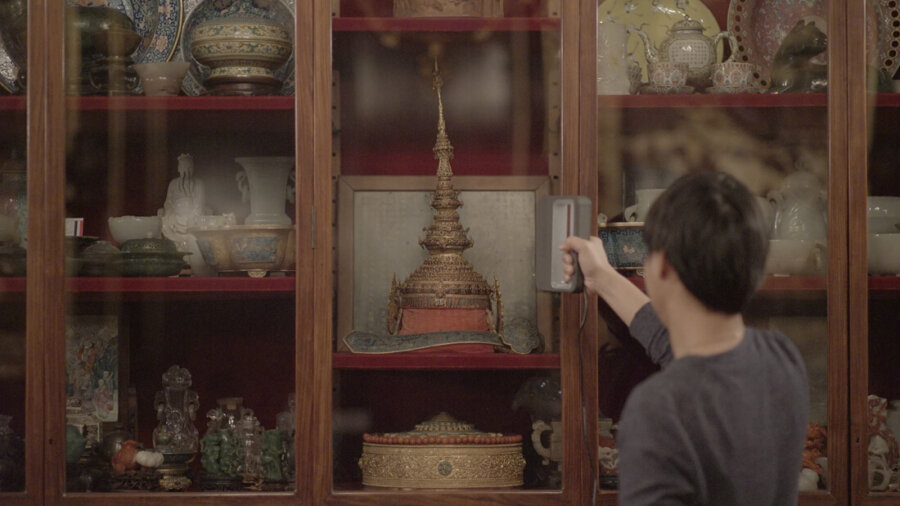
(rubis, saphirs, émeraudes, diamants et perles) ; moules en stéatite. Dimensions variables.
Coproduction Jeu de Paume, Paris ; Fondation Nationale des Arts Graphiques et Plastiques ; CAPC-musée d’art contemporain de Bordeaux et Future Perfect Singapore. Courtesy de l’artiste © Arin Rungjang 2015
Arin Rungjang. Mongkut
Maison d’Art Bernard Anthonioz, Nogent-sur-Marne
From 19 March to 17 May 2015
Extramural
To watch the video portrait:
Arin Rungjang (born 1975, Bangkok) is known for deftly revisiting historical material, overlapping
major and minor narratives across multiple times, places, and languages. His interest lies in
lesser-known aspects of Thai history and their intersection with the present in the sites and
contexts of his practice. Objects, which can draw together distant events across time and space,
are central to his investigations.
Representing Thailand at the 55th Venice Biennale, Rungjang’s Golden Teardrop explored
the transnational adaptation of a celebrated Thai dessert, uncovering surprising narratives and
simultaneities that contradict official history. For the Satellite program 8, the artist’s Mongkut puts
one of Thailand’s cherished symbolic forms at the axis of his inquiry. Rungjang’s research recalls
Franco-Thai relations during the parallel reigns of King Rama IV (1851–68) and Napoleon III
(1852–70), a period marked by the expansion of the European colonial enterprise in much of the
geographic region known today as Southeast Asia.
For centuries prior to this period, Siam was the wealthiest and strongest kingdom in the region.
To avoid colonization, Rama IV famously pursued friendly foreign policies and trade agreements,
effectively balancing the encroaching interests of French and British imperialism. Siam became
the only nation in the region to escape official colonial rule, a legacy that inspires pride but also debate.
In the video installation and sculpture Mongkut, Rungjang uses the present as a context for
reopening a little-known history concerning Siam’s relative sovereignty. Rama IV, known in the West as King Mongkut (meaning “crown” in Thai), twice copied his inherited royal crown. On June 27, 1861 the second replica was offered to Napoleon III by the Siamese ambassador at the Château de Fontainebleau.
Rungjang’s first video presents the visually rich mise-en-scène of the château in somber winter
light, narrated by Pierre Baptiste, renowned curator of Southeast Asian Art at the Musée Guimet. As Baptiste reviews a range of topics from the history of Franco-Thai inter-court relations to the legitimacy of diplomatic offerings and frameworks of display, a young man tours the rooms in solitude, locating the replica in situ, in the drawing rooms of Empress Eugénie, Napoleon III’s wife. Standing at the glass display cabinet, the man casually uses a small, handheld 3D scanner.
The second video is a portrait of Woralak Sooksawasdi na Ayutthaya, King Mongkut’s great, great, great granddaughter. A master craftswoman of theater crowns, she is employed by Thailand’s current queen to propagate royal arts at the Bang Sai Royal Folk Arts and Crafts Centre, north of Bangkok, although her class currently has no students. As Sooksawasdi’s narrative shifts between family genealogy and the royal craft, the camera explores the studio awash with soft tropical light. Amongst
specialized tools and materials, Sooksawasdi and her spouse reference the sensor data acquired by the young man at the château. Ignoring the infinite replication potential offered by the data, they enact the handmade. While the moving image hints at their labors’ goal, Rungjang leaves us with painstaking process. It is in the exhibition that we find Sooksawasdi’s finished masterpiece—the 2015 replica of the
1861 replica of the original 1782 Chakri Royal Crown of Siam.
The complex continuum of Mongkut disturbs the linear chronology we generally inherit. Rungjang’s delicate approach to the symbolic negotiating power of the object deliberately offers only part of the story of Thailand’s qualified sovereignty, past and present. Seen through the lens of the present—a gaze he believes is too immediate to reveal reliable evidence—the latest version of the crown becomes, according to the artist, a “bi-polar looking glass.”
Curator: Erin Gleeson.
Partners: The exhibition is co-produced by the Jeu de Paume,
the Fondation Nationale des Arts Graphiques et Plastiques (FNAGP),
and the CAPC musée d’art contemporain de Bordeaux.
The Friends of CAPC
contribute to the production of works in the Satellite program.
With the kind support of Château de Fontainebleau.
Thank you to Vincent Droguet, Director of Heritage and Collections, Château de Fontainebleau, and Pierre Baptiste, Chief Curator, Southeast Asia, Musée National des Arts Asiatiques–Guimet.
Media Partners:
Art press, ParisArt, Slash-paris.com, Souvenirs from earth TV, Radio Nova, L’oeil, Le Journal des Arts.
